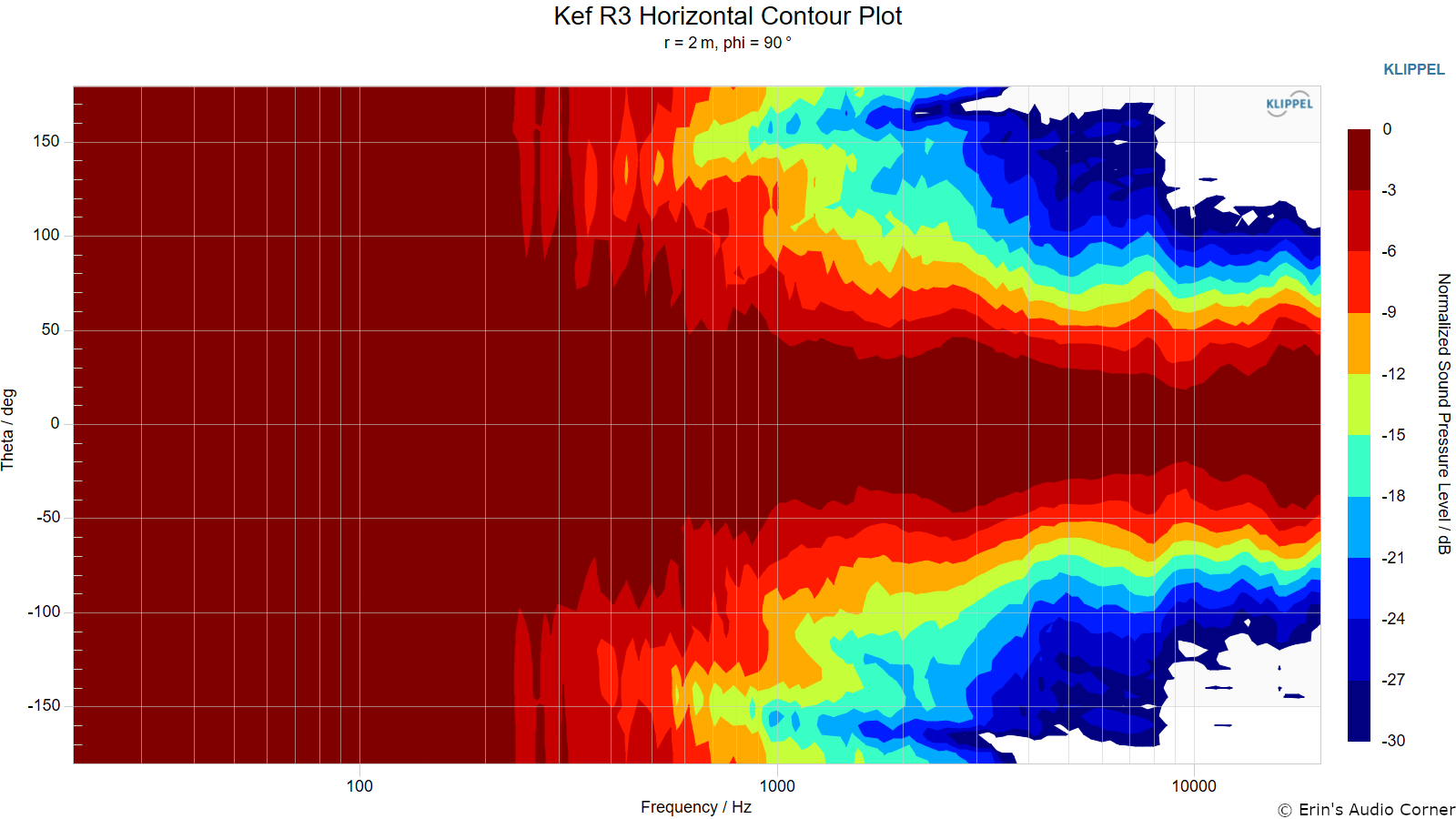so this is where kef got the idea
-
WANTED: Happy members who like to discuss audio and other topics related to our interest. Desire to learn and share knowledge of science required. There are many reviews of audio hardware and expert members to help answer your questions. Click here to have your audio equipment measured for free!
You are using an out of date browser. It may not display this or other websites correctly.
You should upgrade or use an alternative browser.
You should upgrade or use an alternative browser.
KEF R3 meta Measurements
- Thread starter Nuyes
- Start date
-
- Tags
- kef kef r3 kef r3 meta r3 meta
What about kef’s weird bass/port tuning a bit to low and a tad sloping . In the reference series you can choose if you want this or a more normal br tuning with port inserts ? Why not make this selectable on the R series ?
It said to compensate room gain and get a lower fs ? But not many other brands practice this tuning .
Folks must get lucky, I never been overwhelmed by to much bass in any apartment or house I lived in with any equipment ? are kef trying to solve a non problem ?
Actually they supply a port insert but I never really used it. Dont know what it changes. Yes the reason is to get a lower fs. 40Hz is pretty low for a bookshelf Speaker. Most bookshelf speakers don't have usable output below 60Hz. I suspect that active speakers like the KH 150 also use a similar tuning to extent the fs. You just don't see it in the Fr because they EQ it to be flat in the bass. With the R series connected to a proper amp and DSP pre you can also do this.
- Thread Starter
- #83
I plan to measure both horizontal and vertical.Regarding upcoming R6 measurements, will you be positioning it vertically aswell?
- Thread Starter
- #84
I sympathize with what you're saying.First of all. Thank you very much for the measurements. Great job.
I wanted to comment your conclusion above. The directivity of this speaker starts to deviate horizontally around 2000 Hz. Between 2000 Hz and upwards it's overall uniform but not super constant. When we are below 2000 Hz we see that the directivity gradually get's wider. It's not too deviant to 1.5 kHz, but below 1.5 kHz it's collapsing with major changes. At 800 Hz the directivity is around 160°, and increase of approximately 60° compared to the higher frequencies. And below this it get's wider and the distinction from the higher frequencies increases. Obviously we don't care much about what happens below the Schroeder frequency, but we should at least consider the directivity down to 250 Hz area of a speaker.
Vertically, the speaker is much better. While it changes vertically from around 100° till 120° from 4 kHz to 2.5 kHz, it's able to remain a 120° directivty down to around 600 Hz.
I would argue that while it may be beneficial to remain horizontal directivity high in frequency (and especally when the horizontal dispersion is narrow), the directivity between approximately 500 Hz and 5 kHz is much more important to keep constant. This is the most sensitive area to us and deviations in the power response here will greatly effect the sound quality in a normal room with little acoustcial treatment.
However, the reason the normalized directivity meanders in the 1.5kHz, 8k-10kHz range is because there are small dips and peaks in those bands in the frontal frequency response.
Of course, I think it's ideal to have something that's flat in both FR and directivity, like Genelec's active speakers.
Steve Dallas
Major Contributor
R3 Meta from this thread:

R3 from Erin's measurements:

R3 from Erin's measurements:

Last edited:
- Thread Starter
- #86
R3 Meta from this review:

RT3 from Erin's measurements:

These are the directivity data for the Reference 1 Meta that I measured a while back.
The R3 meta shows a noticeable improvement around 15-20 kHz over its predecessor, although the Reference 1 meta still shows a more uniform and beautiful directivity.
Btw, I tend to favor narrow directivity.
exm
Active Member
- Joined
- Sep 21, 2021
- Messages
- 266
- Likes
- 225
Actually they supply a port insert but I never really used it. Dont know what it changes. Yes the reason is to get a lower fs. 40Hz is pretty low for a bookshelf Speaker. Most bookshelf speakers don't have usable output below 60Hz. I suspect that active speakers like the KH 150 also use a similar tuning to extent the fs. You just don't see it in the Fr because they EQ it to be flat in the bass. With the R series connected to a proper amp and DSP pre you can also do this.
The R Series have port plugs whereas the Reference Series have swappable ports: the long tube is about 4.75” long and the short tube is labout 2.75” long.
Last edited:
The port insert in the R series is the block the ports completely to make a closed tuning for even less bass , if your forced to place them very close to a boundary.Actually they supply a port insert but I never really used it. Dont know what it changes. Yes the reason is to get a lower fs. 40Hz is pretty low for a bookshelf Speaker. Most bookshelf speakers don't have usable output below 60Hz. I suspect that active speakers like the KH 150 also use a similar tuning to extent the fs. You just don't see it in the Fr because they EQ it to be flat in the bass. With the R series connected to a proper amp and DSP pre you can also do this.
Thoughts on the impedance dropping below 4ohms at around 42hz and again around 150hz? That region has a lot of information generally speaking and requires a lot of power already to play those notes. Should people cross over to subwoofers above that range to save their amps?
Any pair of speakers that can be used for proper controlling the track ...What is a control pair?
These are "too neutral" for mixing, but it's a (not very expensive) commercial design available for customers with very low distortion in mids, so I'd take it for some kind of "another reference".
Cannot do this properly as you need a significant amount of boost in bass region. The woofers on the r3 in that cabin, cannot handle that level of extra loudness without distorting.Actually they supply a port insert but I never really used it. Dont know what it changes. Yes the reason is to get a lower fs. 40Hz is pretty low for a bookshelf Speaker. Most bookshelf speakers don't have usable output below 60Hz. I suspect that active speakers like the KH 150 also use a similar tuning to extent the fs. You just don't see it in the Fr because they EQ it to be flat in the bass. With the R series connected to a proper amp and DSP pre you can also do this.
Reference still has port plugs if m not wrong on the top of thisThe R Series have port plugs whereas the Reference Series have swappable ports: the long tube is about 4.75” long and the short tube is labout 2.75” long.
Doesn’t it also mean the overall soundstage is limited much close to the boundaries of the speakers as opposed to a speaker with wider directivity ?These are the directivity data for the Reference 1 Meta that I measured a while back.
View attachment 266528
View attachment 266527
The R3 meta shows a noticeable improvement around 15-20 kHz over its predecessor, although the Reference 1 meta still shows a more uniform and beautiful directivity.
Btw, I tend to favor narrow directivity.
- Thread Starter
- #94
I don't think I have universal tastes when it comes to speaker setups.Doesn’t it also mean the overall soundstage is limited much close to the boundaries of the speakers as opposed to a speaker with wider directivity ?
I'm a music producer (that's what I do for a living) and critical monitoring is important to me, so my taste in music has evolved accordingly.
This is my studio, my listening environment.
I'm using an Arendal 1961 Tower, which is a fairly narrow directivity speaker.
Did you buy it after seeing Erin's review on Jan 2022?I'm using an Arendal 1961 Tower, which is a fairly narrow directivity speaker.
The bolded. The horizontal polar is collapsing and is therefore poor. There's no overall uniformity here. It's the opposite.The R3 meta shows a noticeable improvement around 15-20 kHz over its predecessor, although the Reference 1 meta still shows a more uniform and beautiful directivity.
Btw, I tend to favor narrow directivity.
A true uniform or constant directivity will look something like seen below.
Are there any speakers in the same market segment as the R series that don't do this?The bolded. The horizontal polar is collapsing and is therefore poor. There's no overall uniformity here. It's the opposite.
A true uniform or constant directivity will look something like seen below.
View attachment 266571
View attachment 266572
I'm simply pointing out what a uniform directivity actually is. There seems to be misunderstanding here. These are classical collapsing polars and which is not good. Price is irrelevant when we talk about objective performance.Are there any speakers in the same market segment as the R series that don't do this?
I don't see it as a lack of understanding, more a lack of well defined terms to talk about the different patterns.I'm simply pointing out what a uniform directivity actually is. There seems to be misunderstanding here.
I was hoping you did know something that did this below the usual suspects, that are all much more expensive.
Vacceo
Major Contributor
- Joined
- Mar 9, 2022
- Messages
- 2,666
- Likes
- 2,820
Is it me looking at aesthetics or speakers from Perlisten, Arendal and KEF share a lot of elements?I don't think I have universal tastes when it comes to speaker setups.
I'm a music producer (that's what I do for a living) and critical monitoring is important to me, so my taste in music has evolved accordingly.
View attachment 266569
This is my studio, my listening environment.
I'm using an Arendal 1961 Tower, which is a fairly narrow directivity speaker.
Similar threads
- Replies
- 8
- Views
- 2K
- Replies
- 308
- Views
- 58K
- Replies
- 104
- Views
- 14K
- Replies
- 348
- Views
- 66K
- Replies
- 34
- Views
- 4K

